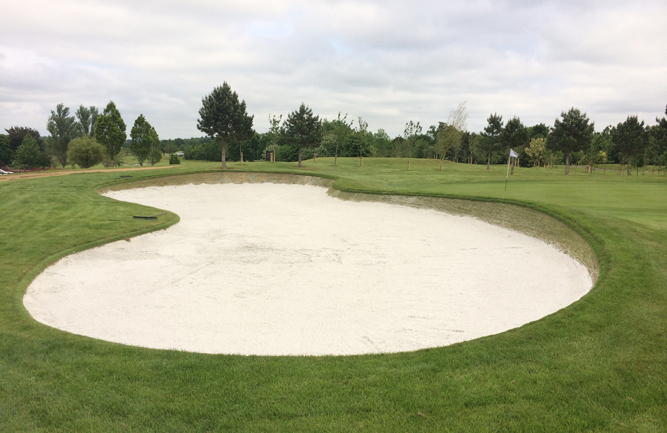Discussing bunker liners with USGA Green Section’s Jim Moore
Jim Moore is director of education for the USGA Green Section. He has more than 30 years of experience in golf course maintenance and construction, and during his career with the USGA he has visited hundreds of golf courses in the United States and internationally. Jim can be reached at jmoore@usga.org for more information.
Q: What is the function of an ideal bunker liner?
The No. 1 function of all bunker liners is to protect sand from contamination by soil beneath and soil on the faces of bunkers. An effective bunker liner prevents soil from eroding and contaminating the sand. By keeping the soil in place, the sand remains clean and water moves rapidly through non-contaminated sand, reducing washouts. The liner also protects soil from clogging the drainage system beneath the bunker.
It’s important to recognize that no bunker liner completely eliminates washouts. The liners may reduce the severity and extent of washouts, but there will be washouts to fix if a severe storm occurs.
Q: In what situations would you recommend bunker liners to a superintendent?
Superintendents should consider bunker liners when:
- Design of the bunker and the area surrounding the bunker requires the bunker to take in a large quantity of water.
- Protection of the investment in bunker sand is desired. Bunker sand can range from $30 to more than $100 per ton delivered, depending on the source, quality and transportation of the sand. The lifespan of bunker sand can be as short as months to a few years if severe storms occur shortly after the sand is installed.
- Bunkers are prone to erosion. Spend the money on a quality liner and a professional installation on bunkers prone to erosion. It may not be necessary to install a liner in every bunker on the golf course.
- The frequency and severity of storms in the superintendent’s geographic region is high. If severe storms and/or abundant rainfall are common, a bunker liner makes sense to prevent sand from becoming contaminated.
Q: When are bunker liners not needed?
Situations where the expense of bunker liners may be difficult to justify include:
- Golf courses with flat-bottomed bunkers and slight or no slope on the bunker faces. Little movement of the sand occurs in these bunkers, which reduces the risk of contamination.
- Arid climates with infrequent intense storms.
- Depending on the tolerance of the bunker liner to machine raking. If your golf course depends heavily on machine raking of bunkers, investigate thoroughly how the liner will stand up to potential damage from the machine. All liners tolerate hand raking.
- They provide no benefit. A bunker liner will not prevent contamination from dust and debris blown into the bunker. If part-circle irrigation heads surrounding the green are adjusted so they start and end their pass over a bunker, washouts and contamination still are a problem.
Q: How should a superintendent decide which bunker liner to purchase?
To my knowledge there has been no side-by-side comparison of bunker liners in the field by an unbiased third party. The good news is that the marketplace is effective in weeding out inferior products. According to the feedback I receive from superintendents, the top three or four bunker liners perform well.
If you are considering installing bunker liners, visit golf courses in your location that are similar to your golf course and find out how its bunker liners have performed.
Q: Is there anything else you would like to add about bunker liners?
For the greatest probability of success, have the bunker liner installed by an experienced, reputable and professional installer. Their experience is worth the expense.
No bunker liner will solve all problems associated with bunkers. Bunker sand quality always will be subjective, and golfers never will agree on the quality of sand in the bunkers.











